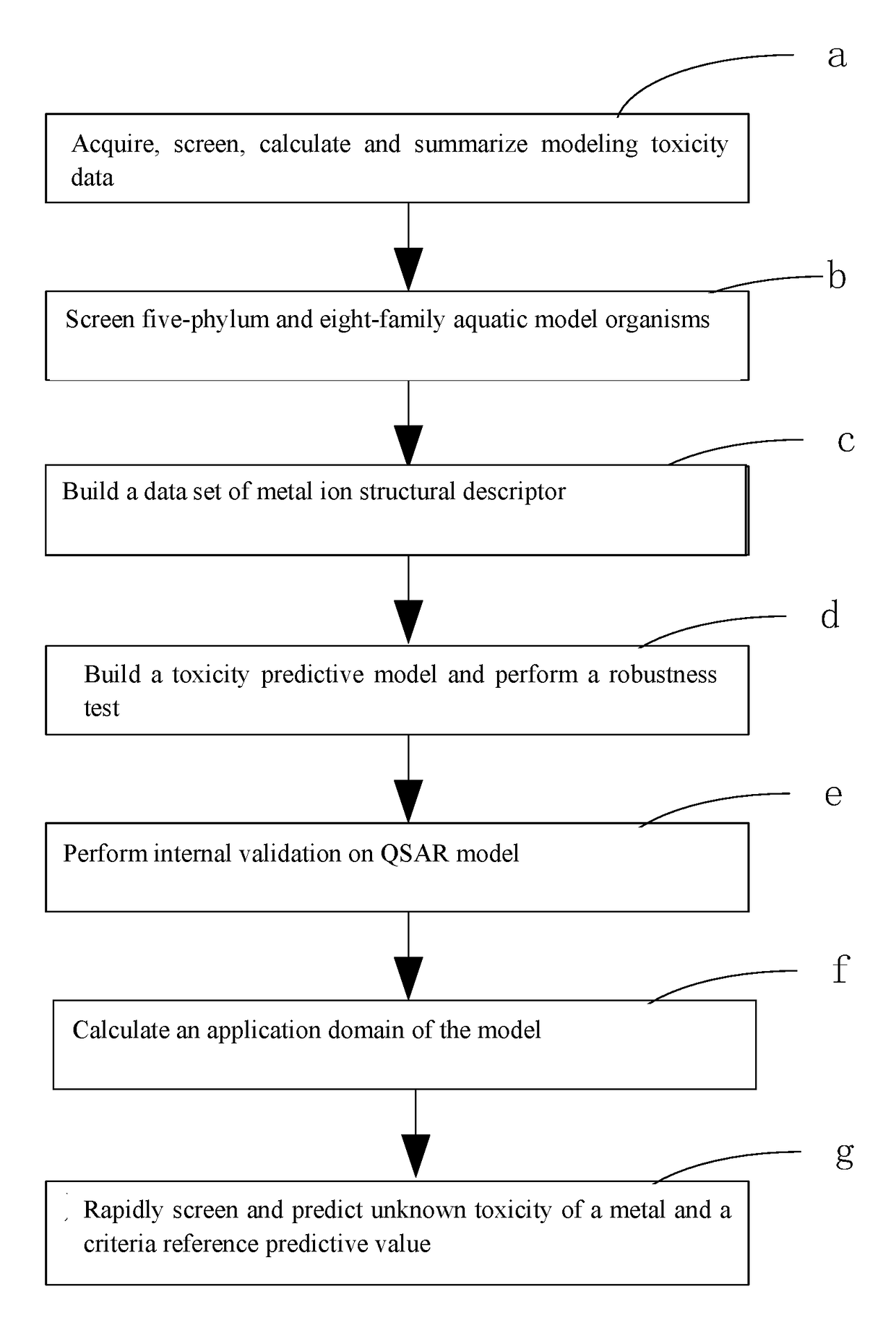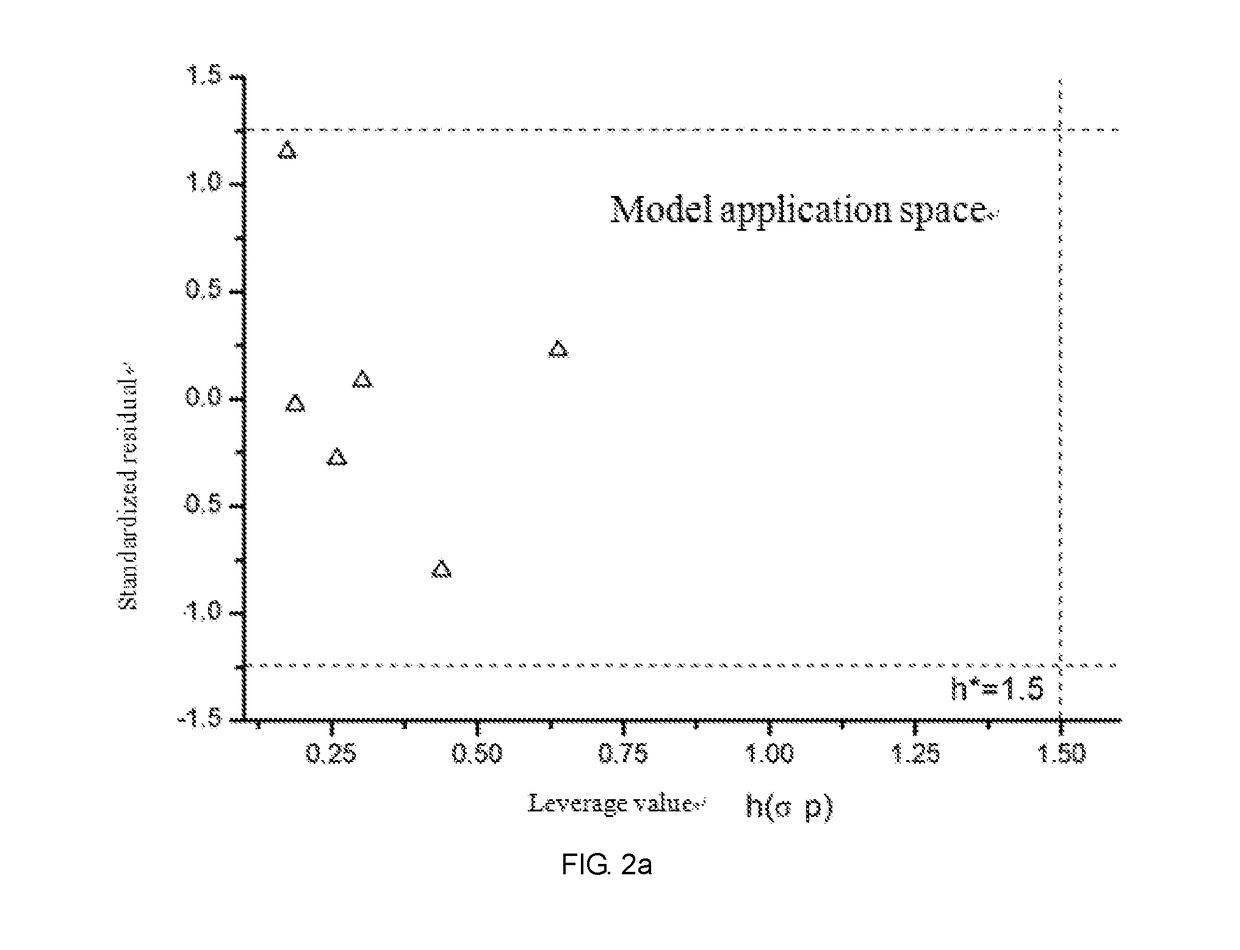Fresh water acute criteria prediction method based on quantitative structure-activity relationship for metals
a technology of quantitative structure and analytical relationship, applied in chemical property prediction, instruments, data processing applications, etc., can solve the problems of harmful influence on an ecological environment and human health, metal form in a complex biological system is difficult to be accurately measured, and metal contamination is one of the most challenging environmental problems
- Summary
- Abstract
- Description
- Claims
- Application Information
AI Technical Summary
Benefits of technology
Problems solved by technology
Method used
Image
Examples
embodiment 1
[0114]Acute toxicity data of Daphnia magna is summarized by adopting the method in the step a of the present invention, as shown in Table 1.
TABLE 1Screening, Operating and Summarizing Examples of AcuteToxicity DataMetalEndpointMolecularEndpointTestedExperimentalEffectExposureDataTypeIndexweight(μmol / L)oganismconditionTypeTimesourceMercury0.022201−0.9608DaphniaTemperature:Fatality48B. S. Silver0.014108−0.8873magna13° C.;ratehoursandCopper0.01464−0.6601pH: 7.6;P. K. Ray.Zinc0.13650.3010DissolvedEcotoxicologyLead8.692071.6230oxygen: 5.6 mg / L;andIron2.92561.7172TotalEnvironmentalNickel5.7591.9850hardness:Safety.240 mg / L1989,18, 109-120
embodiment 2
[0115]Information of five-phylum and eight-family aquatic organisms is preferred by adopting the method in the step b of the present invention, as shown in Table 2.
TABLE 2Preferred Acute and Chronic Model OrganismsSpeciesPhylumFamilyChironomidaeArthropodaChironomidaeOpossum shrimpArthropodaMysidaeDaphnia magnaArthropodaDaphniidaeLymnaeaMolluscaLymnaeidaeCarpChordataCyprinidaeRotiferRotiferBrachionidaeToad larvaeChordataBufonidae(tadpole)DuckweedAngiospermaeAraceae
embodiment 3
[0116]Toxicity values of metal mercury on eight-family model organisms are predicted by the method in the present invention, and a criteria reference value is predicted by combining the SSDs.
[0117]According to the methods in the steps a-d, toxicity predictive equations of the eight-family model organisms are respectively built, as shown in Table 3. Optimized structural parameters of mercury are calculated as follows: σp=0.065, log-βn=21.7, Xm2r=4.08, AN / ΔIP=9.62, Z / r=1.96, |log KOH|=3.4 and ΔE0=0.91. The parameters are sequentially substituted into the equations to obtain the toxicity prediction value of each species.
TABLE 3QSAR Toxicity Predictive Equations of Eight-Family Model OrganismsPredictedSpeciesPredictive equationsR2PvalueChironomidaelog 48h-EC50 = (28.136 ± 18.459)0.7690.012−0.612σp + (−0.150 ± 0.112) log-βn + (0.814 ± 3.625)Opossumshrimplo log 96h-LC50 = (39.716 ± 25.627)0.7910.004−1.252.254 ± 0.136) log-βn + (1.678 ± 4.533)Daphnia magnalog 48h-EC50 = (−0.272 ± 18.674)0....
PUM
 Login to View More
Login to View More Abstract
Description
Claims
Application Information
 Login to View More
Login to View More - R&D
- Intellectual Property
- Life Sciences
- Materials
- Tech Scout
- Unparalleled Data Quality
- Higher Quality Content
- 60% Fewer Hallucinations
Browse by: Latest US Patents, China's latest patents, Technical Efficacy Thesaurus, Application Domain, Technology Topic, Popular Technical Reports.
© 2025 PatSnap. All rights reserved.Legal|Privacy policy|Modern Slavery Act Transparency Statement|Sitemap|About US| Contact US: help@patsnap.com



